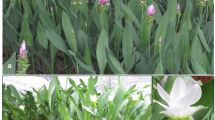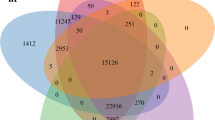Abstract
Centipedegrass (Eremochloa ophiuroides) is an important warm-season grass native to the temperate and tropical regions of China. However, only a few centipedegrass molecular markers were available, which hindered genetic studies. Simple sequence repeats (SSRs) can provide abundant genetic information but the traditional method of their development was time-consuming and labor-intensive. Now, RNA-seq platform provides a relatively fast and financially affordable approach for large-scale development of SSRs. Therefore, the transcriptome of centipedegrass under cold stress was determined using Illumina paired-end sequencing in this study. Based on the 56 million paired-end reads, 45,575 unigenes with an average of 748 nt in length were assembled. A total of 8539 SSR loci were then identified. Among them, the tri-nucleotide SSRs were the most dominant repeat type (60.80%, 5192), followed by mono- (16.56%, 1414), di- (14.28%, 1219), hexa- (3.36%, 287), penta- (2.87%, 245), and tetra-nucleotide (2.13%, 182) repeats. The most frequent repeat units from mono- to hexa-nucleotide repeats were A/T, AG/CT, CCG/CGG, AAAG/CTTT, AGGGG/CCCCT, and AGGGCG/CCCTCG, respectively. We successfully designed 3511 primer pairs, and then, randomly selected 99 pairs to evaluate their interspecific transferability and preliminarily analyze the genetic diversity of centipedegrass accessions. There were 90 primer pairs that could successfully amplify targets in at least one centipedegrass samples, and 81 of them could also function in at least three of six other Poaceae relatives and 79 showed polymorphism. Based on the 79 polymorphic markers, all centipedegrass accessions could be divided into two groups, i.e., group 1 from Guangxi province and group 2 from other regions. The EST-SSRs from this study provided a useful tool and foundation for genetic diversity, linkage mapping, comparative mapping, and molecular marker-aided breeding in centipedegrass.



Similar content being viewed by others
References
Aggarwal RK, Hendre PS, Varshney RK, Bhat PR, Krishnakumar V, Singh L (2007) Identification, characterization and utilization of EST-derived genic microsatellite markers for genome analyses of coffee and related species. Theor Appl Genet 114:359–372
Bai S et al (2002) AFLP fingerprinting analysis of Eremochloa ophiuroides (Munro) Hack germplasm. Gao Ji Shu Tong Xun 10:45–49
Banerjee A, Roychoudhury A (2015) WRKY proteins: signaling and regulation of expression during abiotic stress responses. Scientific World J 2015:807560
Cardle L, Ramsay L, Milbourne D, Macaulay M, Marshall D, Waugh R (2000) Computational and experimental characterization of physically clustered simple sequence repeats in plants. Genetics 156:847–854
Dice LR (1945) Measures of the amount of ecologic association between species. Ecology 26:297–302
Ding Q, Li J, Wang F, Zhang Y, Li H, Zhang J, Gao J (2015) Characterization and development of EST-SSRs by deep transcriptome sequencing in Chinese cabbage (Brassica rapa L. ssp. pekinensis). Int J Genomics 2015:473028
Doyle JJ, Doyle JL (1987) Isolation of plant DNA from fresh tissue. Focus 12:13–15
Dutta S et al (2011) Development of genic-SSR markers by deep transcriptome sequencing in pigeonpea [Cajanus cajan (L.) Millspaugh]. BMC Plant Biol 11:17
Grabherr MG et al (2011) Full-length transcriptome assembly from RNA-Seq data without a reference genome. Nat Biotechnol 29:644–652
Guo W, Wang W, Zhou B, Zhang T (2006) Cross-species transferability of G. arboreum-derived EST-SSRs in the diploid species of Gossypium. Theo Appl Genet 112:1573–1581
Hanna WW, Burton GW (1978) Cytology, repoductive behavior, and fertility charateristics of centipedegrass. Crop Sci 18:835–837
Hanna WW, Dobson J, Duncan RR (1997) Registration of ‘TifBlair’ Centipedegrass. Crop Sci 37:1017
Kantety RV, La Rota M, Matthews DE, Sorrells ME (2002) Data mining for simple sequence repeats in expressed sequence tags from barley, maize, rice, sorghum and wheat. Plant Mol Biol 48:501–510
Kellogg EA (1998) Relationships of cereal crops and other grasses. Proc Natl Acad Sci U S A 95:2005–2010
La Rota M, Kantety RV, Yu JK, Sorrells ME (2005) Nonrandom distribution and frequencies of genomic and EST-derived microsatellite markers in rice, wheat, and barley. BMC Genomics 6:23
Lopez L, Barreiro R, Fischer M, Koch MA (2015) Mining microsatellite markers from public expressed sequence tags databases for the study of threatened plants. BMC Genomics 16:781
Morgante M, Hanafey M, Powell W (2002) Microsatellites are preferentially associated with nonrepetitive DNA in plant genomes. Nat Genet 30:194–200
Peakall R, Smouse PE (2012) GenAlEx 6.5: genetic analysis in Excel. Population genetic software for teaching and research—an update. Bioinformatics 28:2537–2539
Peng JH, Lapitan NLV (2005) Characterization of EST-derived microsatellites in the wheat genome and development of eSSR markers. Funct Integr Genomic 5:80–96
Pertea G et al (2003) TIGR Gene Indices clustering tools (TGICL): a software system for fast clustering of large EST datasets. Bioinformatics 19:651–652
Phukan UJ, Jeena GS, Shukla RK (2016) WRKY transcription factors: molecular regulation and stress responses in plants. Front Plant Sci 7:760
Powell W, Machray GC, Provan J (1996) Polymorphism revealed by simple sequence repeats. Trends Plant Sci 1:215–222
Rolf J (2000) Numerical taxonomy and multivariate analysis system, version 2.10e. Exeter Software, Setauket
Saha MC, Mian MAR, Eujayl I, Zwonitzer JC, Wang L, May GD (2004) Tall fescue EST-SSR markers with transferability across several grass species. Theor Appl Genet 109:783–791
Sharma B, Joshi D, Yadav PK, Gupta AK, Bhatt TK (2016) Role of ubiquitin-mediated degradation system in plant biology. Front Plant Sci 7:806
Sunnucks P (2000) Efficient genetic markers for population biology. Trends Ecol Evol 15:199–203
Tan LQ et al (2013) Floral transcriptome sequencing for SSR marker development and linkage map construction in the tea plant (Camellia sinensis). PLoS One 8:e81611
Thiel T, Michalek W, Varshney RK, Graner A (2003) Exploiting EST databases for the development and characterization of gene-derived SSR-markers in barley (Hordeum vulgare L.). Theor Appl Genet 106:411–422
Varshney RK, Thiel T, Stein N, Langridge P, Graner A (2002) In silico analysis on frequency and distribution of microsatellites in ESTs of some cereal species. Cell Mol Biol Lett 7:537–546
Varshney RK, Graner A, Sorrells ME (2005a) Genic microsatellite markers in plants: features and applications. Trends Biotechnol 23:48–55
Varshney RK et al (2005b) Interspecific transferability and comparative mapping of barley EST-SSR markers in wheat, rye and rice. Plant Sci 168:195–202
Varshney RK et al (2006) Genetic mapping and BAC assignment of EST-derived SSR markers shows non-uniform distribution of genes in the barley genome. Theor Appl Genet 113:239–250
Wang P, Chen Q, Lv Z, Wen M, Wang H, Liu J, Wang X (2009) Evaluation and variation analysis of cold tolerance in Eremochloa ophiuroides. Acta Agrestia Sinica 17:547–551
Wang Z et al (2011) Characterization and development of EST-derived SSR markers in cultivated sweetpotato (Ipomoea batatas). BMC Plant Biol 11:139
Wang H et al (2013) Next-generation sequencing of the Chrysanthemum nankingense (Asteraceae) transcriptome permits large-scale unigene assembly and SSR marker discovery. PLoS One 8:e62293
Wang P, Wang H, Zheng Y, Lv Z, Liu J, Wang X (2014) Genetic mapping and QTL analysis for seed yield, vegetative characters and cold tolerance in centipedegrass. Sci Hortic 176:97–104
Weaver KR, Callahan LM, Caetano-Anolles G, Gresshoff PM (1995) DNA amplification fingerprinting and hybridization analysis of centipedegrass. Crop Sci 35:881–885
Wei W et al (2011) Characterization of the sesame (Sesamum indicum L.) global transcriptome using Illumina paired-end sequencing and development of EST-SSR markers. BMC Genomics 12:451
Wei L et al (2014) Transcriptome analysis of Houttuynia cordata Thunb. by Illumina paired-end RNA sequencing and SSR marker discovery. PLoS One 9:e84105
Xuan J, Guo H, Liu J, Chen S (2003) Initial identification of cold tolerance in the Eremochloa ophiuroides germplasm resource. Acta Prataculturae Sinica 12:110–114
Xuan J, Gao H, Liu J (2005) RAPD analysis of a population of Eremochloa ophiuroides in China. Acta Prataculturae Sinica 14:47–52
Yang S, Liu W, Ma T, Shu B, Liu R, Xie P (2009) Establishment and optimization of ISSR-PCR reaction system of centipedegrass. Grassland and Turf 132:11–14
Zeng S, Xiao G, Guo J, Fei Z, Xu Y, Roe BA, Wang Y (2010) Development of a EST dataset and characterization of EST-SSRs in a traditional Chinese medicinal plant, Epimedium sagittatum (Sieb. Et Zucc.) Maxim. BMC Genomics 11:94
Zhai L, Xu L, Wang Y, Cheng H, Chen Y, Gong Y, Liu L (2014) Novel and useful genic-SSR markers from de novo transcriptome sequencing of radish (Raphanus sativus L.). Mol Breeding 33:611–624
Zhang H, Wei L, Miao H, Zhang T, Wang C (2012a) Development and validation of genic-SSR markers in sesame by RNA-seq. BMC Genomics 13:316–327
Zhang J et al (2012b) De novo assembly and characterisation of the transcriptome during seed development, and generation of genic-SSR markers in peanut (Arachis hypogaea L.). BMC Genomics 13:90
Zhang L, Li Y, Tao A, Fang P, Qi J (2015) Development and characterization of 1,906 EST-SSR markers from unigenes in jute (Corchorus spp.). PLoS One 10:e0140861
Zheng Y, Wang Z, Guo H, Xue D, Liu J (2008) Optimization of SRAP-PCR system on centipedegrass (Eremochloa ophiuroides) using orthogonal design and selection of primers. Acta Prataculturae Sinica 17:110–117
Zheng Y, Zong J, Xue D, Chen X, Liu J (2009) Application of SRAP markers to the identification of Eremochloa ophiuroides (Munro) Hack hybrids. Acta Agrestia Sinica 17:135–140
Zheng X, Pan C, Diao Y, You Y, Yang C, Hu Z (2013a) Development of microsatellite markers by transcriptome sequencing in two species of Amorphophallus (Araceae). BMC Genomics 14:490–501
Zheng Y, Guo H, Zang G, Liu J (2013b) Genetic linkage maps of centipedegrass [Eremochloa ophiuroides(Munro) Hack] based on sequence-related amplified polymorphismand expressed sequence tag-simple sequence repeat markers. Sci Hortic 156:86–92
Zhou Q, Luo D, Ma L, Xie W, Wang Y, Liu Z (2016) Development and cross-species transferability of EST-SSR markers in Siberian wildrye (Elymus sibiricus L.) using Illumina sequencing. Sci Rep 6:20549
Zhu JK (2001) Cell signaling under salt, water and cold stresses. Curr Opin Plant Biol 4:401–406
Acknowledgements
This research was funded by the Guangxi Natural Science Foundation (2012GXNSFBA053037) and the National Natural Science Foundation of China (No. 31460208).
Author information
Authors and Affiliations
Corresponding authors
Additional information
Pengliang Wang and Liping Yang contributed equally to this work.
Electronic supplementary material
Supplementary Table 1
(DOC 161 kb)
Supplementary Table 2
(XLSX 20 kb)
Rights and permissions
About this article
Cite this article
Wang, P., Yang, L., Zhang, E. et al. Characterization and Development of EST-SSR Markers from a Cold-Stressed Transcriptome of Centipedegrass by Illumina Paired-End Sequencing. Plant Mol Biol Rep 35, 215–223 (2017). https://doi.org/10.1007/s11105-016-1017-8
Published:
Issue Date:
DOI: https://doi.org/10.1007/s11105-016-1017-8




